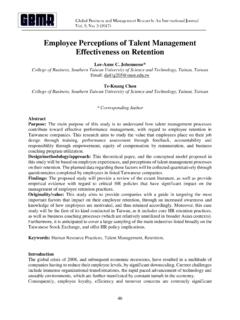Transcription of Building a Cloud Operating Model
1 Building a Cloud Operating Model July 2020 Notices Customers are responsible for making their own independent assessment of the information in this document. This document: (a) is for informational purposes only, (b) represents current AWS product offerings and practices, which are subject to change without notice, and (c) does not create any commitments or assurances from AWS and its affiliates, suppliers or licensors. AWS products or services are provided as is without warranties, representations, or conditions of any kind, whether express or implied. The responsibilities and liabilities of AWS to its customers are controlled by AWS agreements, and this document is not part of, nor does it modify, any agreement between AWS and its customers.
2 2020 Amazon Web Services, Inc. or its affiliates. All rights reserved. Contents Introduction .. 1 Prerequisites .. 2 Target Business Outcomes and Value .. 2 Product based Delivery of Cloud .. 3 Summary of Activities .. 4 Step 1. Work backwards from the Customer .. 5 Step 2. Re-envision the world as products .. 7 Step 3. Organize the teams around products .. 8 Step 4. Bring the work to the teams .. 11 Step 5. Reduce Risk through iteration and automation .. 12 Step 6. Own your own lifecycle .. 12 Next Steps .. 17 Appendix A: Examples of AWS Customer Operating Model Transformations .. 18 Conclusion .. 19 Contributors.
3 19 Further Reading .. 20 Document 20 Abstract Today, many IT leaders want to understand how to adopt Cloud technology while maximizing Cloud benefits, such as business agility, risk reduction, staff efficiency, and cost reduction. This paper outlines the principles for Building a successful Cloud Operating Model that delivers innovative, cost effective, reliable, and secure solutions for the consumption and acceleration of business outcomes by the organizational business units. Amazon Web Services Building a Cloud Operating Model 1 Introduction Establishing an appropriate Cloud Operating Model is critical to forming your organization s successful adoption of Cloud and delivering greater business agility.
4 The impact of the Cloud will be felt across your entire organization (not just Information technology) and will significantly affect, and be affected by, your organizational culture and Information technology delivery structures. Understanding these implications and your company's desire to change are important elements of Building a successful Cloud Operating Model . To support such a transformation, your organization must have a critical mass of people with experience in the Amazon Web Services (AWS) Cloud that can productionize and operate the underlying platform in a product centric approach. Many organizations start by taking a traditional project-based approach adding Cloud as an additional technology layer into their existing Operating Model and landscape.
5 While they may start to realize value and savings from reduced infrastructure spend over traditional and legacy on premise approaches, adding yet another technology into the mix does bring in challenges. Most worryingly it can mean that they are unable to adopt and support new business initiatives at a pace demanded by the business. It is not until one or more of several events and issues arises that many IT leaders are forced into acting and doing something different such as setting up a focused Cloud team / Centre of Excellence. At AWS we refer to this capability as a Cloud Enablement Engine (CEE). This is a branch of Technology and Business resources with a focus on leading the organization on its Cloud adoption journey that maps to the most important needs of the business (and not just Information Technologists).
6 This whitepaper discusses critical elements for creating a successful Cloud adoption capability and identifies mechanisms for acceleration that can be applied prior to a major event or issue. The guide also highlights how the AWS Domain Model can be used to establish an aligning of the Operating Model with the most important needs of the business. Amazon Web Services Building a Cloud Operating Model 2 Prerequisites The Cloud Enablement Engine (CEE) should be aligned to the primary business objectives and outcomes. This ensures that the success of the Cloud adoption will be measured in terms of business benefits from the outset and set the foundation for the Operating Model and prioritization of tasks.
7 A critical prerequisite to the success is the endorsement of organizational leaders and commitment of executive sponsorship in the form of a Cloud Leadership Team. Successful Cloud adopters are disrupting the status quo within their organizations. Without this sponsorship and backing, CEE s will stall and slowdown. For large multi-business unit organizations, the Operating Model may need to apply additional or alternative federated approaches, such as Building a Community of Practice instead of central team. Target Business Outcomes and Value Unlike some of the more technical domains, Building out and establishing a Cloud Operating Model is more fluid in terms of prescriptive outcomes.
8 Our experience in working with successful Cloud Technology Leaders (CIO/CTO) is that they look to establish a Cloud Enablement Engineering (CEE) capability that is value generating before they are faced with failures and firefighting. Examples of value generation seen by some AWS adopters include: 60% reduction in downtime 51% efficiency savings 14x reduction in time to deliver 43% reduction in operational costs Unfortunately, all too often there is a focus solely on the technology of Cloud and it is not until issues arise that that many IT leaders are forced into acting and doing something different. The four most common events are as follows: Bill shock, such as significantly higher Cloud costs than anticipated Operational outages, and a timely struggle to recover Security and data breaches Amazon Web Services Building a Cloud Operating Model 3 Stalled projects caused by an everlasting desire to build the perfect Cloud datacenter project with no return in value A successful Cloud Operating Model (COM) enables organizations to operate applications reliably and securely in the Cloud with a faster pace of innovation and value to the business.
9 A key component of leading COM approaches is the adoption of a Product based approach of the Cloud platform. By adopting a product mindset, each team can take the responsibility and accountability for increased awareness, ownership and operational excellence through self-healing systems that can recover quickly using integrated failure detection and remediation. Platform optimization can also be added through the measurement of known application baselines and testing those baselines using chaos engineering (failure injection) and game days (interactive team-based hands-on learning exercise). Achieving these recommendations most likely needs a culture shift around how organizations design, deploy, and operate their Cloud platform and a focus on automation with repeatable, ongoing processes.
10 Product based Delivery of Cloud Amazon Web Services (AWS) most successful Cloud customers utilize a product mindset to ensure great customer experiences. A product in this context is defined by: 1. Performing a constrained number of common tasks very well, 2. Having clearly defined inputs and outputs, 3. Being useful to multiple customers, and 4. Continuously improved to meet the needs of those customers. For example, uses multiple product teams to run their customer website. Product definition is important as it's the interrelationship between products, the customers that use the products (consumers), and the teams that create the products (suppliers).














